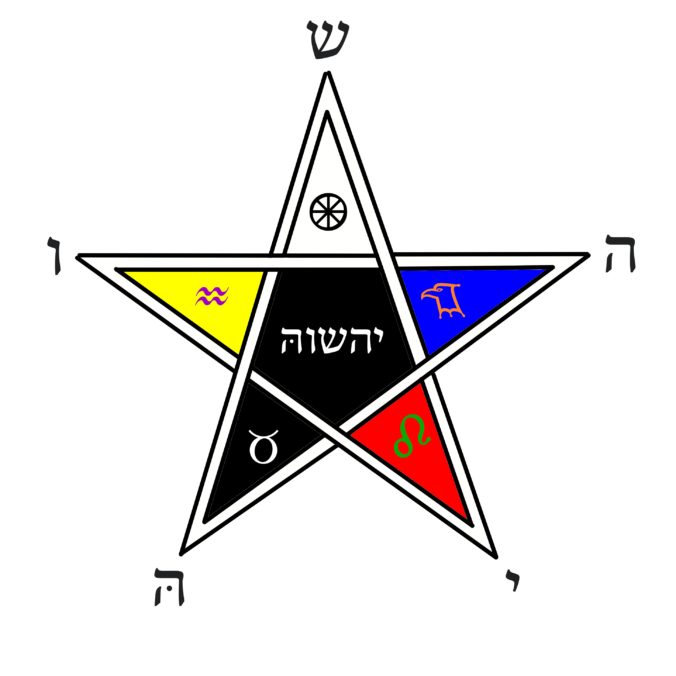With all of the emphasis given to the Lesser Banishing Ritual of the Pentagram, its companion invoking form tends often to get overshadowed. Why should this be? And what is the proper use of the Lesser Invoking Ritual of the Pentagram, anyway?
It turns out, the first question is easier to answer than the second. In contrast to the LBRP, which stands alone as the only ritual traditionally prescribed for students in the Outer Order of the Golden Dawn, the LIRP is quite literally barely a footnote. Regardie says in The Golden Dawn that it should be used “as a form of prayer…in the morning”, but no further attention is given to it.
Historically, there’s a reason for this. As the Adept material on the Pentagram Ritual (again from Regardie) spells out, the “Lesser Ritual of the Pentagram is only of use in general and unimportant invocations”—and such trivial invocations seem not to be worthy of mention to the Golden Dawn founders. Conversely, the LBRP “is permitted to the Outer that Neophytes may have protection against opposing forces, and also that they may form some idea of how to attract and to come into communication with spiritual and invisible things”. Even as a lesser ritual, the banishing serves an important function as a rite of protection—to the point that it is the first and last ceremony performed alongside any other working. The LIRP’s aims, however, are much more generic and ill-defined.
Like the LBRP, the LIRP is a generic microcosmic ritual, just in the invoking form rather than the banishing form. In the same way that the LIRH gets used as an invocation when you’re working with the energies of multiple planets, or of the Macrocosm as a whole, the LIRP is used as an invocation of the sum total of the Elemental or Microcosmic world. Unlike the Greater or Supreme Pentagram Rituals, the Lesser Pentagram Ritual does not specify any one force in its invocation, and consequently it is—as Regardie relates—a general rite “to attract and come into communication with spiritual and invisible things”.
In other words, whereas the LBRP magnetically repels spiritual energy on the microcosmic level, the LIRP magnetically attracts it. This can be a bit of a crap shoot given that you aren’t calling upon or drawing in any specific influences, but it does have its place. The Lesser Banishing Ritual serves to shoo away any astral interlopers, sweep out the dust bunnies, and prepare a clean working space–but it also leaves you in a nice and clean but ultimately empty house. The Lesser Invoking Ritual, on the other hand, is more like sending out a message blast to all the people you know saying they’re welcome to drop on by your house and hang out with you. You might attract some company for the evening, but you don’t really know what energy you’re going to be getting out of the bargain.
Now, this lack of differentiation is what makes the LIRP a lesser ritual rather than a greater or supreme ritual. The “lesser” rituals are general, not differentiated for any specific planet or element. The “greater” rituals specify a unique element or planet in the banishing or invoking. And the “supreme” rituals are like the greater ones, except using the Enochian tablets—which is also why you don’t have a Supreme Hexagram Ritual distinct from the Greater Hexagram Ritual, even though different sources use the two terms interchangeably: the Enochian tablets are terrestrial watchtowers, and so only have appropriate reference with respect to the Pentagram Ritual.
Now that said, the question you may be asking yourself at this point is “what’s the actual use of the LIRP?” And that’s a harder question to answer, because the LIRP was never intended to be used for any sort of operant or practical magic. The LBRP is used to create the protective magic circle, but if you’re invoking any specific forces you’re going to be using the corresponding greater/supreme ritual rather than a lesser ritual.
When I was in the HOGD we never used the LIRP for much of anything, and my Temple emphasized the LBRP exclusively. That doesn’t mean the LIRP has no value, but the value it does have is going to be subtle and it’s not something that necessarily needs to be prescribed for the Neophyte for any particular purpose. Moreover, the conventional wisdom is that you want to spend an extended period of time focusing only on banishing with a given ritual before you start invoking it: if you’re going to make mistakes in the learning process, you want to do that while you’re in this stage of banishing without doing any accompanying invoking. It’s best to mess up when you aren’t actively trying to dismiss a spiritual entity you’ve already called up beforehand!
I’ve heard that in the Druidical Order of the Golden Dawn, ovates in training are supposed to shift back and forth between doing the LIRP in the morning and the LBRP at bedtime on the one hand, and performing the LBRP in the morning and the LIRP at bedtime on the other. The rationale behind this is that it allows each person to see how these subtle energetic differences impact them when doing it one way versus the other. This is the kind of experimentation I can fully get behind, and I may incorporate this idea into my own practice in order to obtain a better feel for the different shadings of flavor between the two.
So even though the LIRP is but a literal footnote in the much larger Golden Dawn system, once you’re sufficiently comfortable and practiced with performing the LBRP, I encourage you to experiment with performing the LIRP at different times of day and under different circumstances to get a feel for how it functions and what effects it has for you. After all, it’s only through experimentation that the system thrives and grows.

Leave a Reply